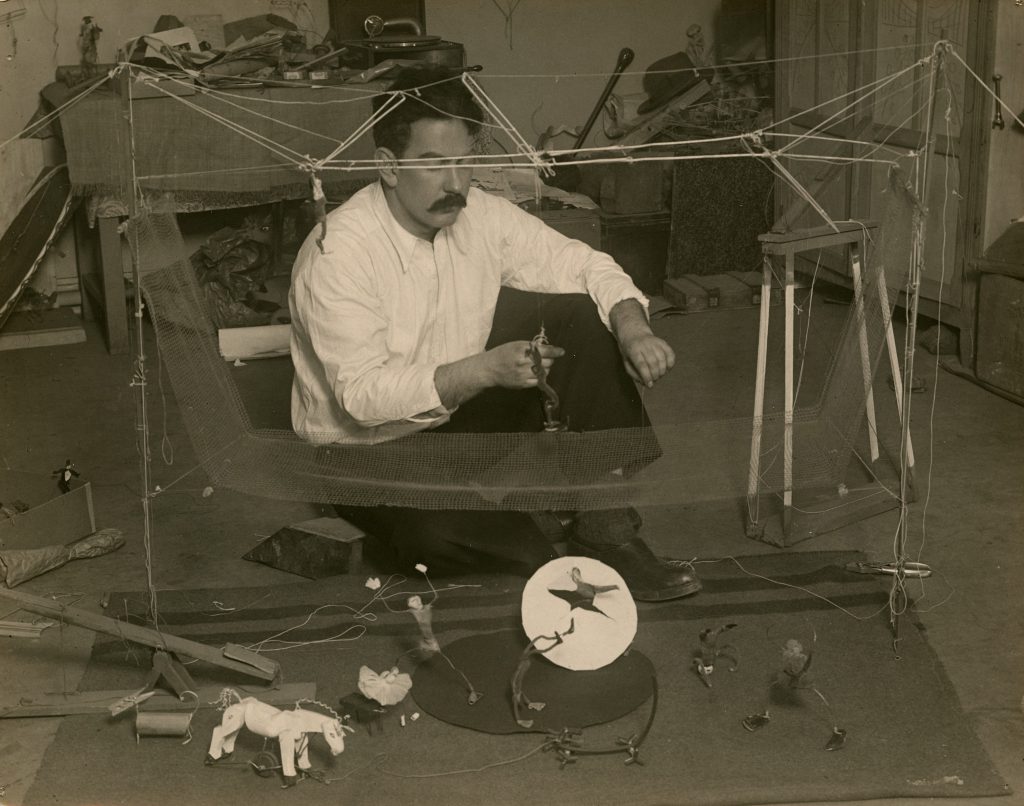

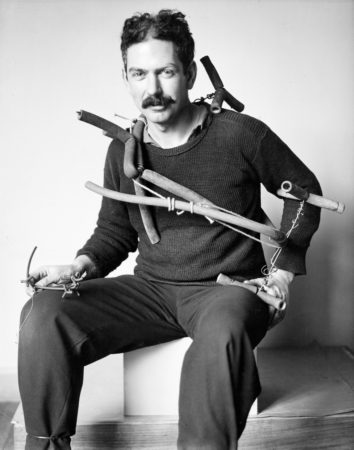
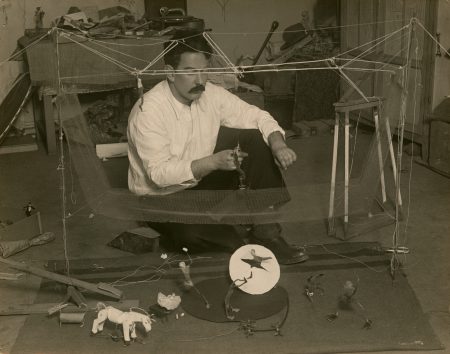
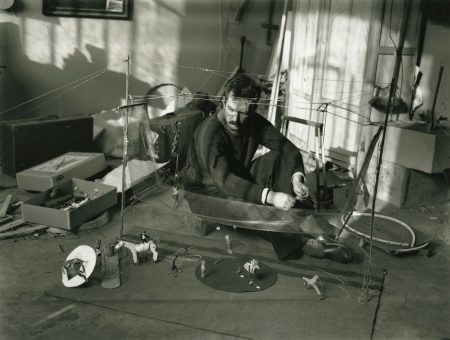
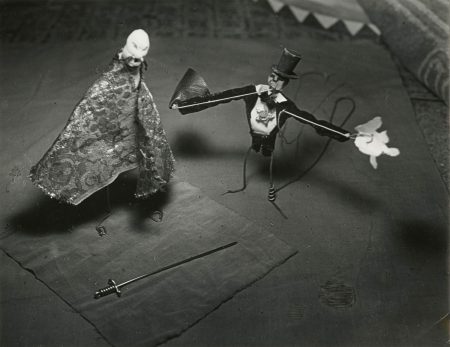
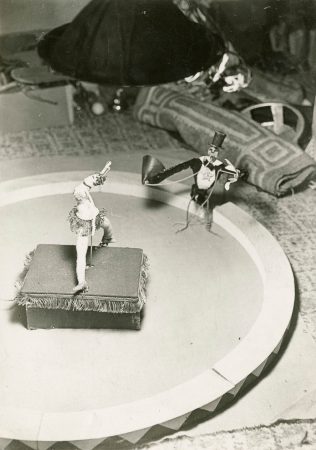
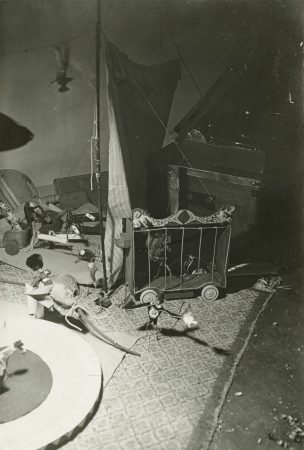
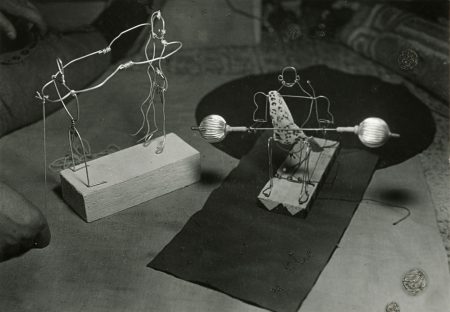
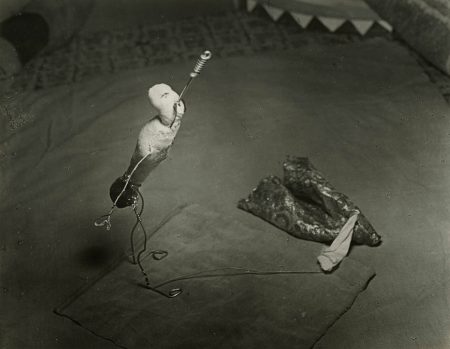
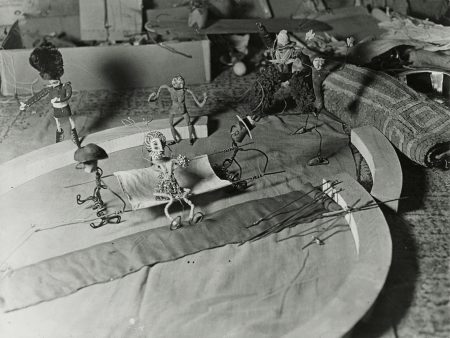
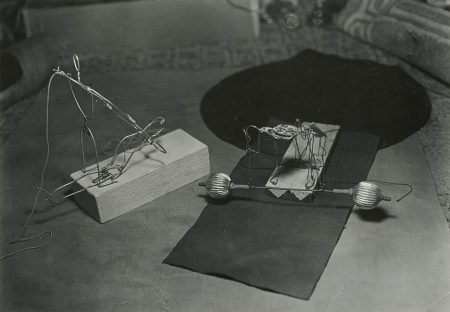
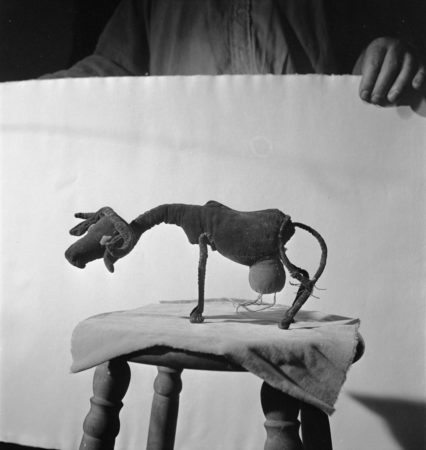
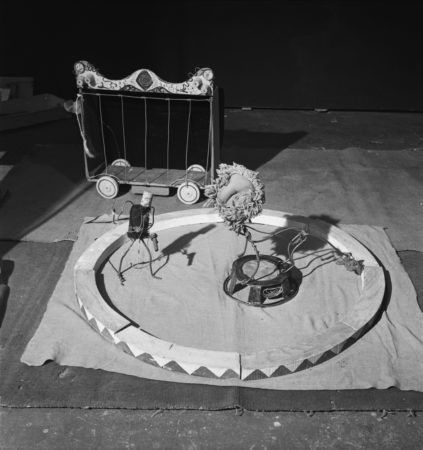
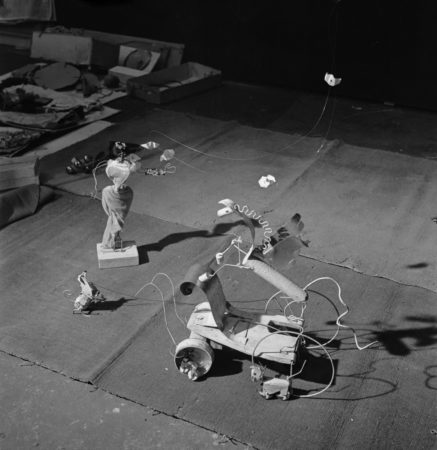
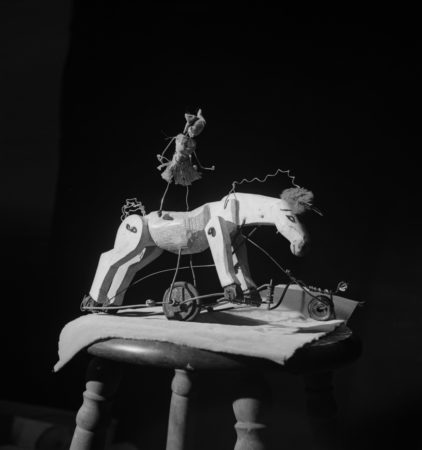
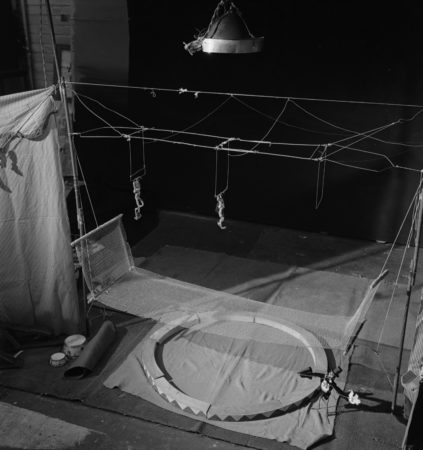
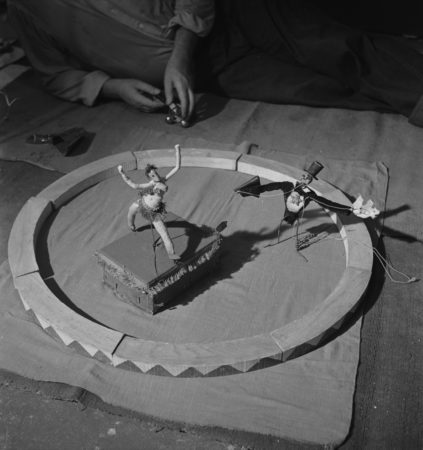
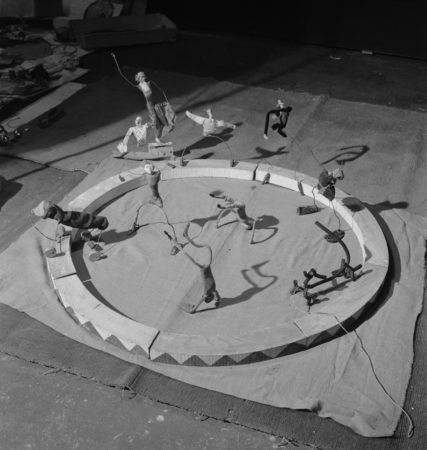
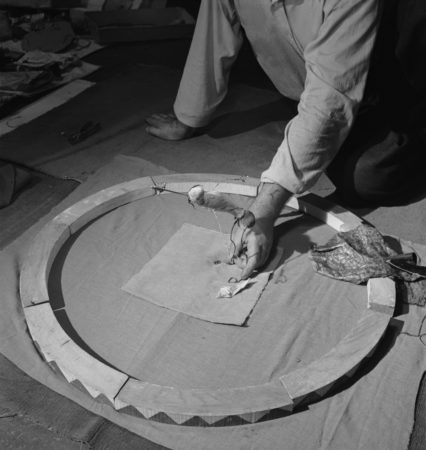
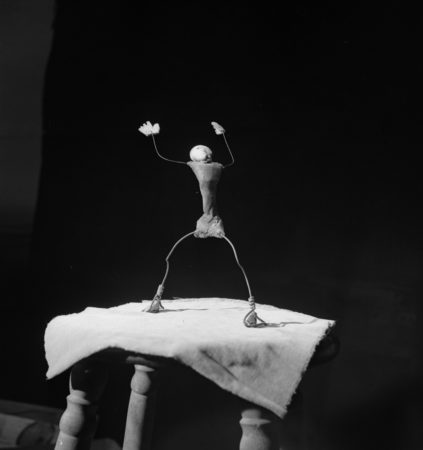
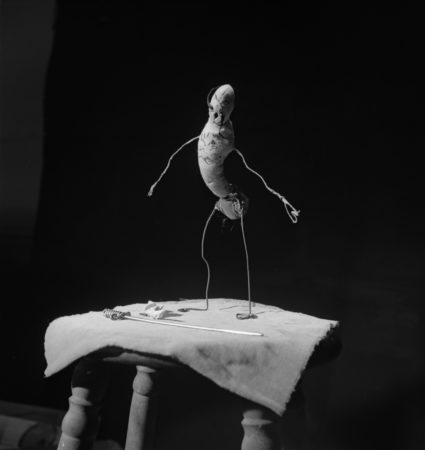
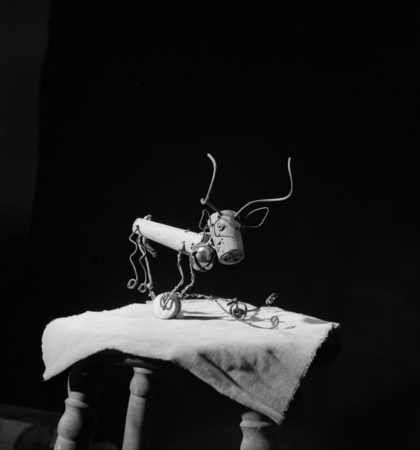
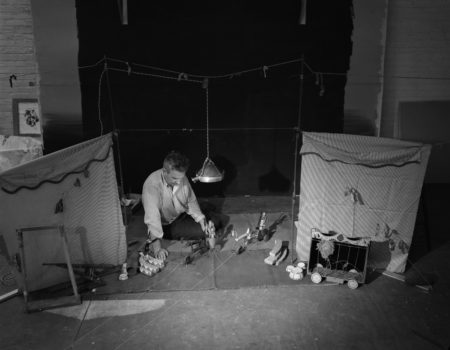

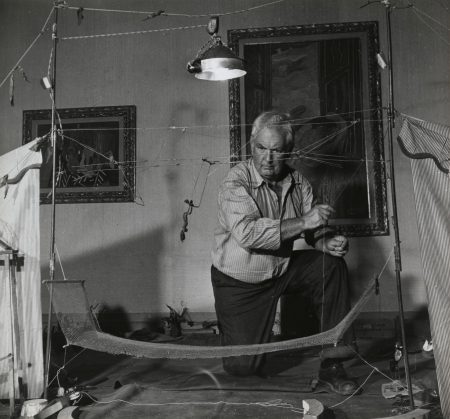
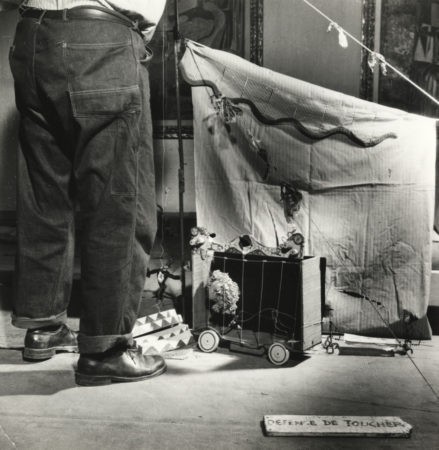
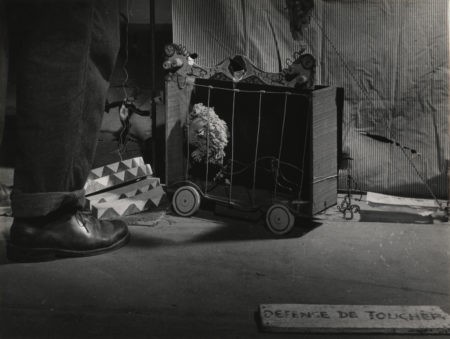
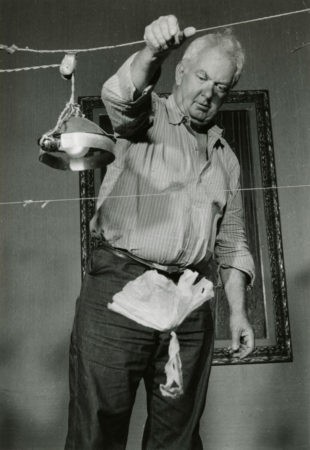
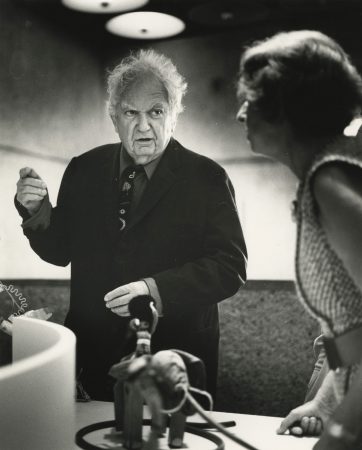
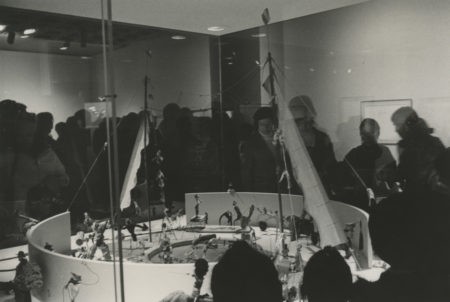
Solomon R. Guggenheim Museum, New York. Alexander Calder: A Retrospective Exhibition. 6 November 1964–31 January 1965.
Solo ExhibitionMusée National d’Art Moderne, Paris. Calder. 8 July–15 October 1965. Originated from the Solomon R. Guggenheim Museum, New York.
Solo ExhibitionFondation Maeght, Saint-Paul-de-Vence, France. Calder. 2 April–31 May 1969.
Solo ExhibitionWhitney Museum of American Art, New York. Calder’s Universe. 14 October 1976–6 February 1977.
Solo ExhibitionMusée National d’Art Moderne, Centre Georges Pompidou, Paris. Alexander Calder: les années parisiennes 1926–1933. 18 March–20 July 2009. Originated from the Whitney Museum of American Art, New York.
Solo ExhibitionCalder, Alexander. “Voici une petite histoire de mon cirque.” In Permanence du Cirque. Exhibition Catalogue. Paris: Revue Neuf, 1952.
General ReferenceFondation Beyeler, Riehen/Basel. Alexander Calder & Fischli/Weiss. Exhibition catalogue. 2016.
Alexander S. C. Rower, Cirque Calder
Group Exhibition CatalogueCalder begins creating Cirque Calder, a complex and unique body of art. Fashioned from wire, fabric, leather, rubber, cork, and other materials, Cirque Calder is designed to be performed for an audience by Calder. It develops into a multi-act articulated series of mechanized sculpture in miniature scale, a distillation of the natural circus. Calder is able to travel with his easily transportable circus and hold performances on both continents. Over the next five years, Calder continues to develop and expand this work of performance art to fill five large suitcases.
Calder performs Cirque Calder for Mrs. Frances C. L. Robbins, a patron of young artists. On her recommendation, English novelist Mary Butts comes to see it and in turn sends Jean Cocteau to a performance.
Réal brings Guy Selz and the circus critic, Legrand-Chabrier, to see Calder perform Cirque Calder. Legrand-Chabrier admires Calder’s work and writes several articles on the Cirque. Oh, these are stylized silhouettes, but astonishing in their miniature resemblance,
obtained by means of luck, iron wire, spools, corks, elastics . . . A stroke of the brush, a stroke of the knife, of this, of that; these are the skillful marks that reconstruct the individuals that we see at the circus.
Here is a dog who seems like a prehistoric cave drawing with a body of iron wire. He will jump through a paper hoop. Yes, but he may miss his mark or not. This is not a mechanical toy . . .
All of this is arranged and balanced according to the laws of physics in action so that it allows for the miracles of circus acrobatics.
Calder returns to New York and rents a room at 46 Charles Street where he gives Cirque Calder performances.
Calder visits Miró at his Montmartre studio, a sort of metal tunnel, a kind of Quonset hut. Miró has no paintings in the studio, but he shows Calder a collage, a big sheet of heavy gray cardboard with a feather, a cork, and a picture postcard glued to it. There were probably a few
dotted lines . . . I was nonplussed; it did not look like art to me. Later, Miró attends Cirque Calder at Calder’s rue Cels studio. Miró says, “I liked the bits of paper best.” These are little bits of white paper, with a hole and slight weight on each one, which flutter down several variously coiled thin steel wires, which I jiggle so that they flutter down like doves onto the shoulder of a bejeweled circus belle dame.
Sacha Stone, a German photographer, sees Calder perform Cirque Calder at the rue Cels studio. He suggests that Calder perform and exhibit in Berlin.
I have had 2 large circus parties since coming back to Paris. At one of them we had Paul Fratellini, one of the famous clowns at the Cirque d’Hiver. It was quite a swell party—and I am making one of the toys in a size large enough for him to use in the Cirque d’Hiver.
Calder performs Cirque Calder in the studio of Tsuguharu Foujita, a painter and well-known denizen of Montparnasse. Foujita plays a drum to accompany Calder’s performance. Man Ray and Kiki are among the guests in attendance.
Calder embarks for New York on the De Grasse, bringing Cirque Calder with him. During the voyage, he meets Edward Holton James and his daughter Louisa. So once on board the De Grasse, I started walking the deck. I overtook an elderly man and a young lady. I could only see them
from the back, so I reversed my steps the better to see them face on. Upon coming abreast of them the next time around, I said, “Good evening!” And the man said to his daughter, “There is one of them already!” He was Edward Holton James, my future father-in-law. She was Louisa. Her father had just taken her to Europe to mix with the young intellectual elite. All she met were concierges, doormen, cab drivers—and finally me.
Calder performs Cirque Calder at Hawes’s couture house, 8 West Fifty-sixth Street, New York.
Calder performs Cirque Calder at art patron Mildred Harbeck’s apartment, 306 Lexington Avenue, New York.
Calder stays with his friend, book designer Robert Josephy, at Beekman Place and Fiftieth Street. Josephy was very enthusiastic over my circus. This encouraged me and while at his house, I worked on it very hard. He helped me. We made the chariot race and the lion tamer,
and it got to be quite a full blown circus, growing from two suitcases into five.
After the New Yorker announces that performances of Cirque Calder can be arranged through the Junior League Entertainment Center at Saks Fifth Avenue, Calder is hired by Newbold Morris to perform in his Babylon, Long Island, home; Isamu Noguchi operates a phonograph providing the music.
Fifty-Sixth Street Galleries, New York, exhibits “Alexander Calder: Paintings, Wood Sculpture, Toys, Wire Sculpture, Jewelry, Textiles.” Calder performs Cirque Calder at the show’s vernissage on 1 December.
Calder performs Cirque Calder in the home of Aline Bernstein on Park Avenue. Noguchi is present, as is Thomas Wolfe, who later incorporates a wry fictionalized account of the event into his novel, You Can’t Go Home Again.
Calder performs Cirque Calder on New Year’s Eve at the home of Jack and Edith Straus on West Fifty-seventh Street, New York.
Calder performs Cirque Calder at artist Margarett Sargent’s house, 205 Commonwealth Avenue, Boston.
Calder stays in the apartment of his friend Paul Nitze at 112 East Fortieth Street. At Nitze’s request, he performs Cirque Calder.
Harvard Society for Contemporary Art, Cambridge, Massachusetts, exhibits “Wire Sculpture by Alexander Calder.” Calder performs Cirque Calder for the faculty and students on 31 January.
Calder performs Cirque Calder in his studio at 7 Villa Brune. For seating, he invites spectators to bring their own boxes.
Calder performs Cirque Calder in his studio at 7 Villa Brune.
In need of money to pay rent, Calder charges admission to performances of Cirque Calder. I bought planks, pinched some boxes, and made bleachers. I handled thirty people an evening on, I believe, four evenings. At the end of my professional run, the concierge came and said the
proprietor who lived in the front could not get to sleep on account of the cymbals.
On the advice of Frederick Kiesler, a Viennese architect, Calder invites Le Corbusier, Karl Einstein, Fernand Léger, Piet Mondrian, and Theo van Doesburg to a presentation of Cirque Calder at 7 Villa Brune. To avoid conflicts, Kiesler insists that Calder send a telegram
inviting van Doesburg for the following night.
Van Doesburg and his wife, Pétronella [Nelly], attend a performance of Cirque Calder. I got more of a reaction from Doesburg than I had from the whole gang the night before.
Calder prints postcards to announce performances of Cirque Calder at 903 Seventh Avenue, New York. Five performances are given; each audience includes about thirty spectators.
Calder performs Cirque Calder at the James’s home in Concord, Massachusetts.
Calder performs Cirque Calder in his studio at 14 rue de la Colonie.
Calder performs Cirque Calder in his studio at 14 rue de la Colonie.
Calder exhibits with Abstraction-Création at Porte de Versailles, Paris, and performs Cirque Calder.
Calder performs Cirque Calder in his studio at 14 rue de la Colonie.
The Calders visit Louisa’s parents in Concord. Calder performs Cirque Calder at the James’ home.
While visiting Calder’s parents in Richmond, Massachusetts, Calder performs Cirque Calder in an old barn that Stirling uses as a studio. Invitees include Nitze, Drew, and Josephy.
The Calders arrive at the Miró farm in Montroig for an eight- to ten-day visit. During their stay, Calder performs Cirque Calder for the Mirós, their farmhands, and their neighbors. Miró recalls the event: He came to Montroig and brought the circus figures; he never stopped working on
them. We organized a presentation for the local farmers who were very pleased with the spectacle of the wire performers. Later the Cirque was presented in galleries, but there in Montroig it was really a performance for the people.
The Calders return to Barcelona and visit Gaudí’s basilica. Invited by the Amics de l’Art Nou, Calder performs Cirque Calder in the hall of the Grup d’Arquitects i Tecnics Catalans per al Progres de l’Arquitectura Contemporania (GATCPAC). Shortly thereafter, the Calders return to Paris.
Calder performs Cirque Calder in his studio at 14 rue de la Colonie.
Calder performs Cirque Calder in his studio at 14 rue de la Colonie.
Works by Calder are presented at the Sociedad de Cursos y Conferencias, Residencia de Estudiantes de la Universidad de Madrid. Calder also performs Cirque Calder for the students.
Calder performs Cirque Calder in Barcelona.
Calder performs Cirque Calder at the Park Avenue home of Mr. & Mrs. Huntington Sheldon.
“Mobiles by Alexander Calder” is held at the Renaissance Society at the University of Chicago; Sweeney writes the preface for the catalogue. On the 16th and 19th of January, Calder gives performances of Cirque Calder in the University of Chicago’s Wieboldt Hall for the Renaissance
Society. He also performs at the home of Walter S. Brewster, a trustee of the Art Institute of Chicago, on 20 January.
Calder and Louisa visit Charlotte Whitney Allen in Rochester, New York. While there, Calder constructs the large standing mobile she had commissioned for her garden and he gives a performance of Cirque Calder.
Calder performs Cirque Calder in New York at the Pierre Matisse Gallery.
Calder performs Cirque Calder in his apartment at 244 East Eighty-sixth Street and Second Avenue, New York.
Calder performs Cirque Calder at 80 boulevard Arago, Paris.
The Calders arrive in Folkstone, England, later renting an apartment at Belsize Park, London. Calder establishes a studio in Camden Town and gives Cirque Calder performances.
Calder performs Cirque Calder in Roxbury.
Calder performs Cirque Calder at Herbert and Mercedes Matter’s apartment, 328 East Forty-second Street, New York.
Calder performs Cirque Calder in the Roxbury studio. Yves Tanguy assists.
Calder gives two performances of Cirque Calder in the Members Room of the Museum of Modern Art, New York, for friends and staff.
Calder’s Black Flower is loaned by the Russian Embassy in Washington, D.C., to “Calder: Paintings, Mobiles, Stabiles and Jewelry,” held at the local gallery France Forever. Calder attends the preview on 26 March, organized under the patronage of Henri Hoppenot, Minister
Plenipotentiary, Delegate of the French Committee of National Liberation, and he performs Cirque Calder on 25 and 26 March at the Dance Playhouse, through the courtesy of Evelyn Davis.
Calder holds a performance of Cirque Calder in the family’s Roxbury studio for his daughters. I have to show the children how to run it so that they can carry on.
Calder performs Cirque Calder at his home in Roxbury for the Mirós; Henri Seyrig (Director of the Institut Français d’Archéologie); and Henrique and Helena Mindlin.
Calder performs Cirque Calder at the Sert’s home in Lattingtown, New York.
Calder presents Cirque Calder in Roxbury.
Calder presents Cirque Calder in Washington, D.C.; Jean invites “what seemed half of Washington, D.C., to see it.”
Calder performs Cirque Calder in Roxbury.
Galerie la Hune, Paris, exhibits “Permanence du Cirque.” The exhibition commemorates the publication of a book by the same title, which includes an essay by Calder, “Voici une petite histoire de mon cirque.”
Calder performs Cirque Calder at Galerie Maeght Paris.
Calder leaves Aix for Paris to begin filming Cirque de Calder, directed by Jean Painlevé.
Calder performs Cirque Calder in Saché.
Carlos Vilardebó directs Le Cirque Calder, a film with narration by Calder.
Art in America and Perls Galleries publishes Calder’s Circus, a portfolio of sixteen unbound lithographs with a text by Cleve Gray and a reproduction of a letter from Miró describing Calder’s 1932 performance of Cirque in Montroig.
Calder’s Work in Progress is performed by the Teatro dell’Opera, Rome. For thirty years I have been thinking about a production that would be entirely mine, form and music working together. I long ago discussed this with Massine, but he insisted on having dancers. I later made
stage sets, but this is not exactly what I wanted to do … for Satie’s Socrate, Pichette’s Nucléa, John Butler’s The Glory Folk in Spoleto, for Joe Lazzini in Marseille. The idea of a production that was totally mine had already come to me in spirit in 1926 when I finished the Cirque, and when I tried to frame it in a stage opening, amusing myself by thinking it an actual theatre.
Soon after moving to Paris in 1926, Calder created his Cirque Calder. Made of wire and a spectrum of found materials, the Cirque was a work of performance art that gained Calder an introduction to the Parisian avant-garde. He continued to explore his invention of wire sculpture, whereby he “drew” with wire in three dimensions the portraits of friends, animals, circus themes, and personalities of the day.